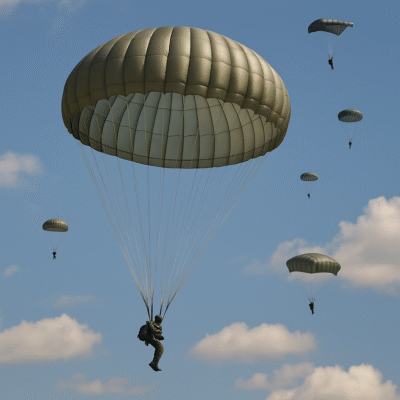In today’s evolving tactical landscape, airborne operations remain one of the most reliable methods for inserting troops and equipment into challenging environments. Whether conducting covert HALO missions, static line insertions, or cargo drops, the success of the mission starts with choosing the right parachute system. That’s why understanding the types of military parachutes is critical to mission planning and operational safety.
At Aerodyne, we specialize in providing military clients with a wide selection of mission-ready parachutes, each engineered for specific tactical applications. This article explores the most common types of military parachutes, their key features, and which Aerodyne systems match those needs best.
Why Parachute Selection Matters in Military Operations
Different missions demand different descent profiles, load capacities, and maneuverability. Selecting the wrong parachute can lead to:
Reduced insertion accuracy
Increased injury risk
Mission failure
Understanding the types of military parachutes ensures airborne units can plan with confidence, knowing their equipment is built for success.
1. Static Line Parachutes
Overview
Static line parachutes are deployed automatically as the jumper exits the aircraft. A line connected to the aircraft pulls the deployment bag, ensuring the parachute opens immediately.
Best For
Mass troop insertions
Training jumps
Low-altitude operations (typically 800–1,500 feet AGL)
Aerodyne Product Match
T10 Non-Steerable Parachute
Designed for simplicity and durability
Ideal for training schools and basic mass drop operations
Features MIL-C-7020 1.1 oz ripstop nylon canopy
MC1-1B / MC1-1C (Steerable Variants)
Incorporates control toggles for basic steering
Used in tactical insertions requiring controlled landings
Related reading: Non-Steerable Parachute Systems
2. Steerable Parachutes
Overview
Steerable parachutes allow jumpers to guide their descent, offering improved accuracy and obstacle avoidance—especially in limited drop zones.
Best For
Tactical insertions
Jump zones with terrain hazards
Precision landings
Aerodyne Product Match
MC1 Series
Field-tested steerable parachutes used globally
Equipped with control lines for mid-air maneuvering
Ideal for military teams operating in unpredictable terrain
Explore: Military Parachute Systems
3. HALO/HAHO Parachutes
Overview
HALO (High Altitude Low Opening) and HAHO (High Altitude High Opening) jumps are advanced airborne techniques that allow for stealth insertions from high altitudes. Jumpers may descend for miles, requiring maximum glide and oxygen support.
Best For
Covert operations
High-altitude insertions (up to 35,000 feet)
Long-distance glide missions
Aerodyne Product Match
M7 Tactical Parachute System
High-performance freefall canopy
Glide capability up to 30+ kilometers
Integrates with oxygen systems and thermal suits
ZPX-Tactical
Ultra-lightweight high-altitude parachute
Designed for special operations where silence and glide are mission critical
Learn more: Airborne Insertion Techniques
4. Cargo Parachutes
Overview
Cargo parachutes are used for delivering supplies, equipment, and vehicles into combat or remote zones. These systems are engineered to withstand heavier weights and impact forces.
Best For
Supply drops
Heavy equipment delivery
Emergency resupply missions
Aerodyne Product Match
Aerodyne Tactical Cargo Drop Systems
Can support medium-to-heavy payloads
Designed with impact-absorbing suspension and reinforced canopies
Custom configurations available for specialty missions
5. Training Parachutes
Overview
Training parachutes are designed to mimic real deployment behavior while providing safety and reusability for jump schools and military academies.
Best For
Paratrooper training
Repetitive drills
Non-combat airborne simulations
Aerodyne Product Match
Modified T10 Training Kits
Engineered for durability
Built to mirror real descent profiles
Cost-effective without sacrificing quality
Recommended: Parachute Training Systems
How to Choose the Right Military Parachute
Mission Objective
Choose based on whether the goal is stealth, mass drop, or cargo delivery.
Drop Zone Environment
Assess terrain hazards, size of the zone, and approach angle.
Load Requirements
Ensure the system supports total weight: jumper + gear + optional oxygen or weapon systems.
Altitude and Weather Conditions
High-altitude operations require enhanced canopies, oxygen integration, and wind adaptability.
Need support choosing the right system? Contact us today to find out more
Why Aerodyne Is the Global Choice for Military Parachutes
Full Product Line: From static line to HALO, we supply a full range of military parachutes.
Proven Performance: Our systems meet or exceed MIL-STD-858 and NATO STANAG 2338.
Integrated Accessories: Thermal suits, oxygen kits, breakaway rucksacks, and more.
Global Deployment: Aerodyne systems are fielded in over 30 countries.
Visit the Home Page for an overview of our systems and accessories.
Understanding the types of military parachutes is critical to operational planning, safety, and mission success. Whether deploying a full battalion, supplying critical equipment, or executing a high-altitude special operation, Aerodyne has the technology, reliability, and global experience to deliver unmatched performance.
Each mission is unique. Every parachute system must be, too.
Partner with Aerodyne—for precision at every altitude.

